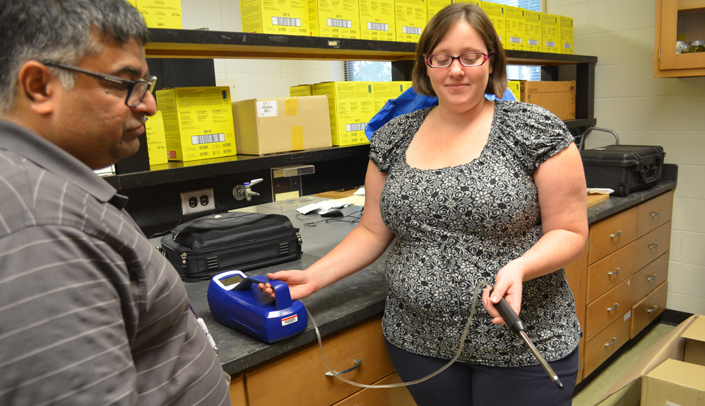When you have a community of researchers and students dedicated to public health, it only makes sense to use them.
That’s one reason that UNMC’s Safety Office has been working with the College of Public Health on a variety of exposure and risk assessments.
Designed to enhance
UNMC Business & Finance provides funding for this program. The program was designed to enhance the safety program by leveraging resources to take advantage of the knowledge and expertise of the faculty and staff of the College of Public Health and to provide research opportunities and workplace experiences for COPH students.
Chandran Achutan, Ph.D., associate professor of environmental, agricultural and occupational health, leads the project from the college side, working with public health graduate students to design exposure assessments.
“If you want to measure how much chemical exposure people who work in labs might have, for example, you want to use the right exposure assessment methodology,” he said. “Until we came aboard, there was not that kind of expertise on campus.”
John Hauser, safety manager for UNMC, said he was interested in leveraging resources the moment he heard that UNMC was starting a College of Public Health.
“We wanted to tap into the knowledge and expertise the College of Public Health was bringing to UNMC,” he said. “In the past, we had to contract with off-site vendors for things such as air-quality investigations and exposure monitoring. When the college was first being started, I asked if there would be a faculty member with an industrial hygiene background.”
Dr. Achutan had that background, and today the safety office works with other members of the college, as well.
The college helps with any kind of indoor air quality investigation.
“If people say the building where they’re working is causing health issues, we’ve helped investigate that,” Dr. Achutan said.
The partnership has been in place for nearly four years, focusing not only on airborne chemical exposures, but also workplace safety practices.
“Right now, we’re looking at noise exposures,” Dr. Achutan said. “We try to identify areas on campus that have loud noise sources and see how loud the noise is — we’ve just started working at the central utilities plant.”
The college is also helping to refine the hearing conservation program for the campus.
In addition to the benefit of the campus, there is a learning element to the partnership. The graduate students taking measurements and assessing risks are garnering valuable real world experience.
“We had one student who just finished his capstone research looking at general lab safety on campus,” Dr. Achutan said.
“There are a lot of benefits to both sides,” Hauser agreed.
